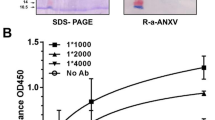Abstract
Purpose
To investigate the relationship between hyaluronan binding (HB) assay and pregnancy rates in intrauterine insemination (IUI) cycles.
Methods
This prospective cohort study was done in Hacettepe University, a tertiary care center for reproductive medicine. Seventy-one consecutive couples who suffered from unexplained infertility and underwent controlled ovarian hyperstimulation (COH) and IUI were enrolled into the study.
Results
From the 71 IUI patients, the clinical pregnancy rate was 14.1 % (10 of 71). HB ratio from the overall patient number was 48.6 ± 25.9. The mean HB ratio in pregnant and non-pregnant groups was comparable (50.2 ± 25.2 vs. 48.3 ± 26.2, respectively, p > 0.05).
Conclusions
Hyaluronan binding assay does not predict pregnancy rates in IUI cycles in couples with unexplained infertility.
Similar content being viewed by others
References
Guzick DS, Overstreet JW, Factor-Litvak P, Brazil CK, Nakajima ST, Coutifaris C, Carson SA, Cisneros P, Steinkampf MP, Hill JA, Xu D, Vogel DL (2001) Sperm morphology, motility, and concentration in fertile and infertile men. N Engl J Med 345(19):1388–1393. doi:10.1056/NEJMoa003005
Agarwal A, Said TM (2003) Role of sperm chromatin abnormalities and DNA damage in male infertility. Hum Reprod Update 9(4):331–345
Bastiaan HS, Windt ML, Menkveld R, Kruger TF, Oehninger S, Franken DR (2003) Relationship between zona pellucida-induced acrosome reaction, sperm morphology, sperm-zona pellucida binding, and in vitro fertilization. Fertil Steril 79(1):49–55
Davis RO, Katz DF (1993) Operational standards for CASA instruments. J Androl 14(5):385–394
Drahorad J, Tesarik J, Cechova D, Vilim V (1991) Proteins and glycosaminoglycans in the intercellular matrix of the human cumulus-oophorus and their effect on conversion of proacrosin to acrosin. J Reprod Fertil 93(2):253–262
Huszar G, Ozenci CC, Cayli S, Zavaczki Z, Hansch E, Vigue L (2003) Hyaluronic acid binding by human sperm indicates cellular maturity, viability, and unreacted acrosomal status. Fertil Steril 79(Suppl 3):1616–1624
Huszar G, Ozkavukcu S, Jakab A, Celik-Ozenci C, Sati GL, Cayli S (2006) Hyaluronic acid binding ability of human sperm reflects cellular maturity and fertilizing potential: selection of sperm for intracytoplasmic sperm injection. Curr Opin Obstet Gynecol 18(3):260–267. doi:10.1097/01.gco.0000193018.98061.2f
Jakab A, Sakkas D, Delpiano E, Cayli S, Kovanci E, Ward D, Revelli A, Huszar G (2005) Intracytoplasmic sperm injection: a novel selection method for sperm with normal frequency of chromosomal aneuploidies. Fertil Steril 84(6):1665–1673. doi:10.1016/j.fertnstert.2005.05.068
Kovacs P, Kovats T, Sajgo A, Szollosi J, Matyas S, Kaali SG (2011) The role of hyaluronic acid binding assay in choosing the fertilization method for patients undergoing IVF for unexplained infertility. J Assist Reprod Genet 28(1):49–54. doi:10.1007/s10815-010-9479-3
Ye H, Huang GN, Gao Y, de Liu Y (2006) Relationship between human sperm–hyaluronan binding assay and fertilization rate in conventional in vitro fertilization. Hum Reprod 21(6):1545–1550. doi:10.1093/humrep/del008
Nijs M, Creemers E, Cox A, Janssen M, Vanheusden E, Van der Elst J, Ombelet W (2010) Relationship between hyaluronic acid binding assay and outcome in ART: a pilot study. Andrologia 42(5):291–296. doi:10.1111/j.1439-0272.2009.00992.x
Parmegiani L, Cognigni GE, Bernardi S, Troilo E, Ciampaglia W, Filicori M (2010) “Physiologic ICSI”: hyaluronic acid (HA) favors selection of spermatozoa without DNA fragmentation and with normal nucleus, resulting in improvement of embryo quality. Fertil Steril 93(2):598–604. doi:10.1016/j.fertnstert.2009.03.033
Tarozzi N, Nadalini M, Bizzaro D, Serrao L, Fava L, Scaravelli G, Borini A (2009) Sperm–hyaluronan-binding assay: clinical value in conventional IVF under Italian law. Reprod Biomed Online 19(Suppl 3):35–43
Conflict of interest
None.
Author information
Authors and Affiliations
Corresponding author
Rights and permissions
About this article
Cite this article
Boynukalin, F.K., Esinler, I., Guven, S. et al. Hyaluronan binding assay does not predict pregnancy rates in IUI cycles in couples with unexplained infertility. Arch Gynecol Obstet 286, 1577–1580 (2012). https://doi.org/10.1007/s00404-012-2476-2
Received:
Accepted:
Published:
Issue Date:
DOI: https://doi.org/10.1007/s00404-012-2476-2




